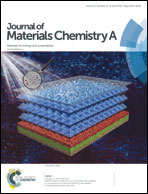Narrow bandgap non-fullerene acceptor based on a thiophene-fused benzothiadiazole unit with a high short-circuit current density of over 20 mA cm−2†
Abstract
In this work, we have designed and synthesized two new non-fullerene acceptors (NFAs) based on a thiophene-fused benzothiadiazole (BTT) unit as a π-bridge to connect an indacenodithiophene (IDT) as the central core and 3-otcylrhodanine (A1) or 3-otcyl-2-(1,1-dicyanomethylene)rhodanine (A2) as the terminal group. Compared with the analogous structure of IDT-2BR, which possesses a benzothiadiazole (BT) unit as a π-bridge, the fusion of an aromatic thiophene ring onto the BT unit not only extends the conjugation length, but also stabilizes the quiniod conjugation system, which greatly strengthens the intramolecular charge transfer (ICT) effect. Meanwhile, the introduction of an electron-withdrawing ester group at the fused thiophene ring also intensifies the ICT effect, thus leading to more red-shifted absorption and a reduction in the bandgap. Moreover, because the 3-otcyl-2-(1,1-dicyanomethylene)rhodanine unit with a strong electron-withdrawing malononitrile group further strengthens ICT and stabilizes the quinoid structure more than the 3-otcylrhodanine unit, A2 shows a deeper red-shifted absorption compared with A1, which is favourable for improving the light-harvesting efficiency and enhancing the short-circuit current density (Jsc). The photovoltaic performances of organic solar cell (OSC) devices based on A1 or A2 as the acceptor and PTB7-Th as the donor have been investigated in detail. It was found that the device based on A1:PTB7-Th only displays a power conversion efficiency (PCE) of 5.79%, whereas the PCE of the A2:PTB7-Th-based device with 1% DIO reaches 9.07% with a Jsc of over 20.33 mA cm−2, which is one of the highest Jsc values among IDT-2BR-type NFA-based OSCs. This work provides further insight into the structural design of new deep narrow bandgap NFAs with high efficiency in OSCs.


 Please wait while we load your content...
Please wait while we load your content...